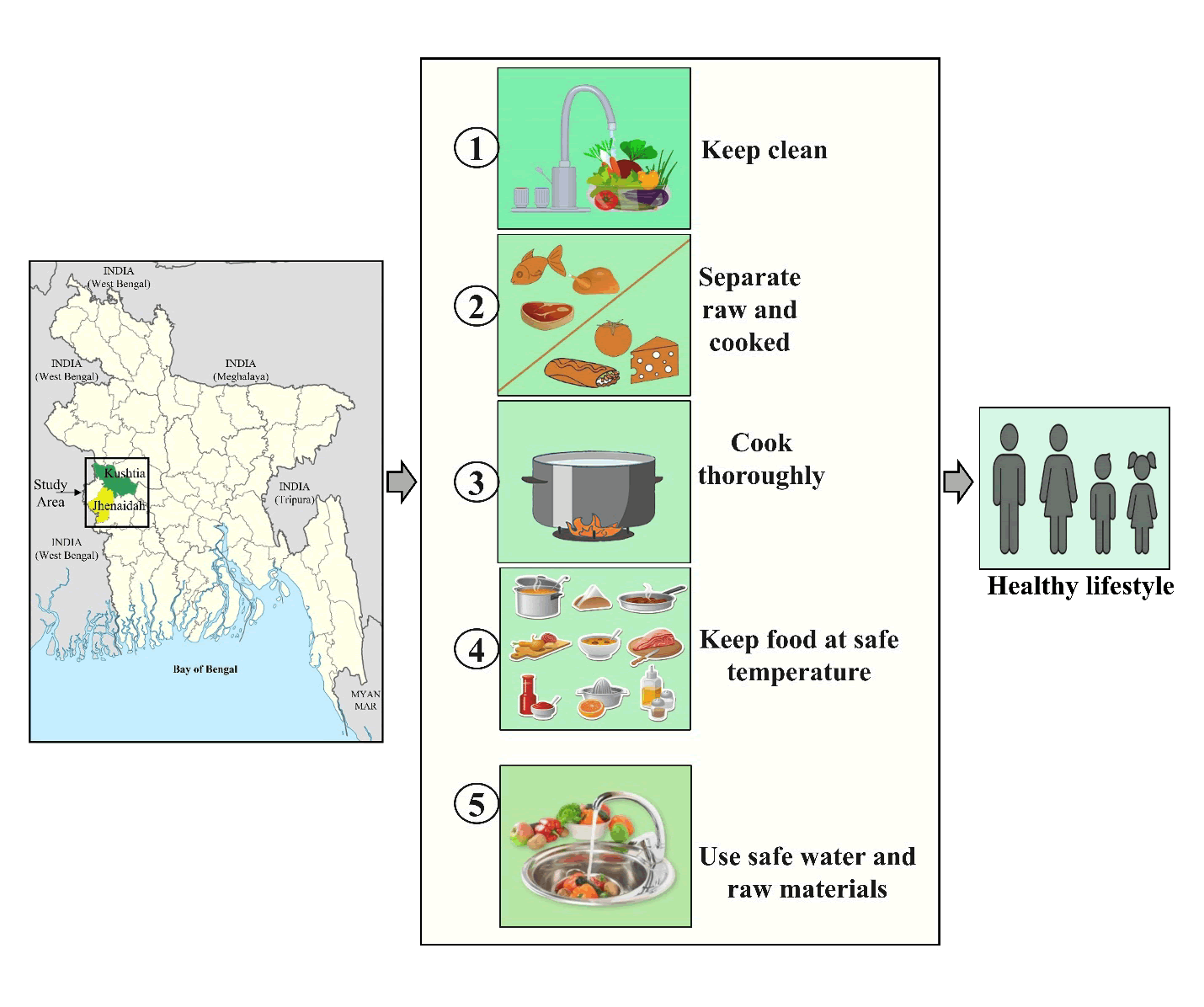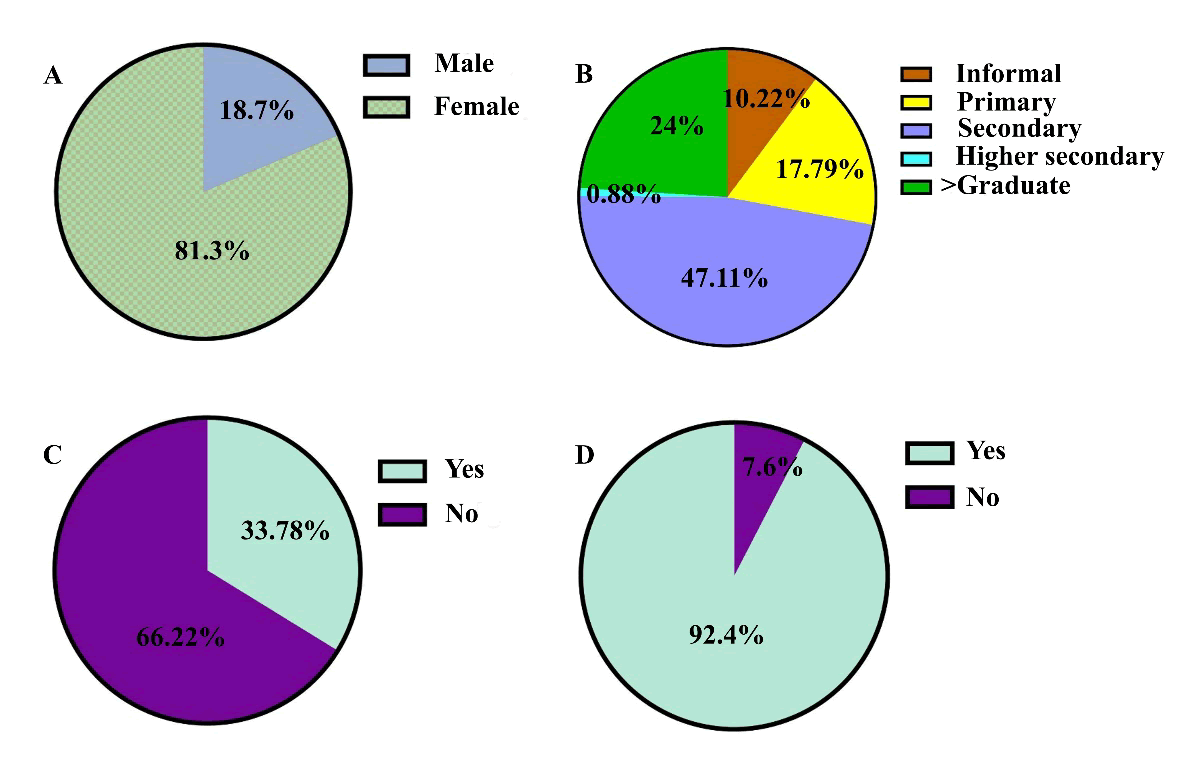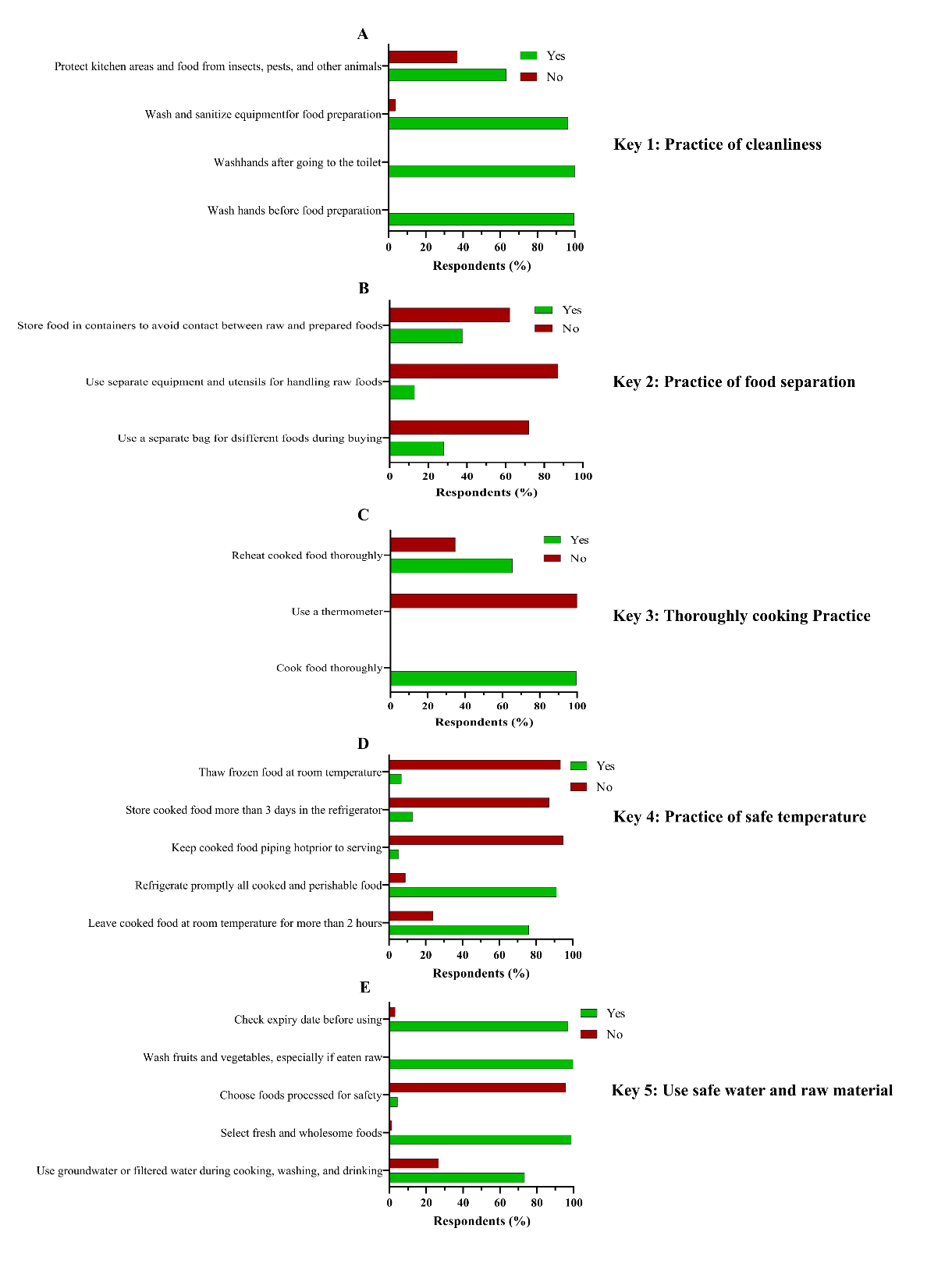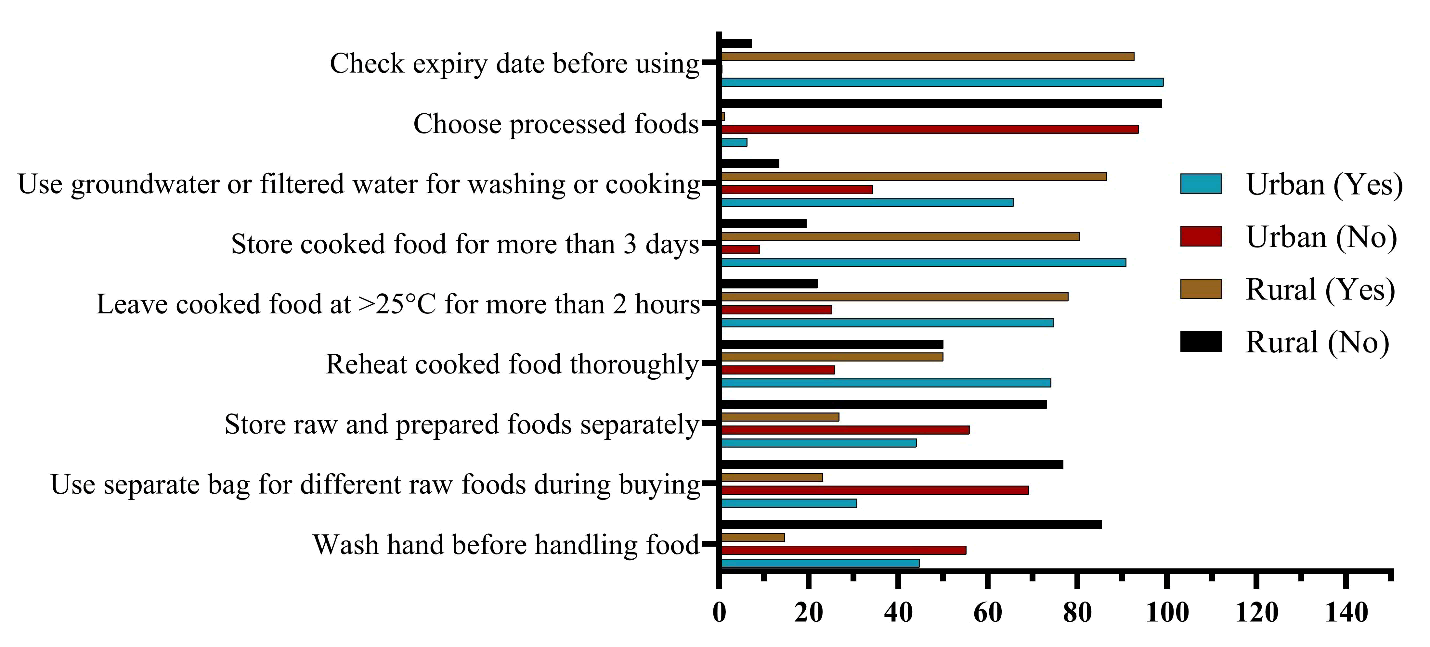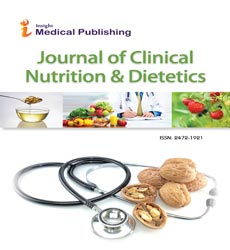Practices on Safer Food among Household Food Handlers in the South-West Region in Bangladesh
Mahade Hasana, Opshora Islam Zayeda, Nasrin Sultana, Shammy Akter, Shaikh Shahinur Rahman, M. Rezaul Karim and M. Mominul Islam*
Received Date: 2024-09-25 | Published Date: 2025-05-20Mahade Hasana, Opshora Islam Zayedaa, Nasrin Sultanaa, Shammy Akter, Shaikh Shahinur Rahman, M. Rezaul Karim and M. Mominul Islam*
Department of Applied Nutrition and Food Technology, Faculty of Biological Science, Islamic University, Kushtia, Bangladesh
- *Corresponding Author:
- M. Mominul Islam Department of Applied Nutrition and Food Technology, Faculty of Biological Science, Islamic University, Kushtia, Bangladesh E-mail:momin@anft.iu.ac.bd
Received: September 25, 2024, Manuscript No. IPJCND-25-19709; Editor assigned: September 27, 2024, PreQC No. IPJCND-25-19709 (PQ); Reviewed: October 11, 2024, QC No. IPJCND-25-19709; Revised: May 13, 2025, Manuscript No. IPJCND-25-19709 (R); Published: May 20, 2025, DOI: 10.36648/2472-1921.11.2.160
Citation: Hasana M, Zayedaa OI, Sultanaa N, Akter S, Rahman SS, et al. (2025) Practices on Safer Food among Household Food Handlers in South- West Region in Bangladesh. J Clin Nutr Diet Vol. 11 No. 2: 160.
Abstract
Foodborne illnesses and deaths are all too common worldwide, primarily due to contaminated food, water and poor hygiene and sanitation practices during food preparation and handling. Food safety is a significant concern for public health on a global scale, particularly in developing countries such as Bangladesh. To prevent foodborne illnesses, it is crucial to adhere to appropriate food safety management procedures. The "WHO five keys to safer food" play a critical role in ensuring food safety. In this study, a cross-sectional survey was conducted through face-to-face interviews with 225 domestic food handlers in the South West region of Bangladesh. The results revealed that the majority of home food handlers lacked sufficient knowledge and practice in food safety and none of the respondents had received formal training in food preparation or hygiene. The study recommends the implementation of proper training programs for food handlers to enhance their understanding of food safety. Additionally, it emphasizes the importance of the government and local stakeholders prioritizing efforts to reduce foodborne illnesses and fatalities in Bangladesh.
Keywords
Food safety; Food handlers; WHO five keys; Bangladesh
Introduction
Safe and properly proportioned food is essential for a healthy life because consuming unsafe food can lead to foodborne illnesses. These illnesses pose significant health risks and result in economic losses for individuals. Each year, more than 500 million people experience health issues and approximately 500,000 people die due to contaminated food. Compared to Europe and the United States, South-East Asia has a higher incidence of foodborne illnesses and deaths, with over 150 million people falling ill and 170,000 deaths occurring annually. Children in Southeast Asia are particularly vulnerable, with 50,000 children under the age of five dying from foodborne diseases in the region.
Food safety is closely linked to national food and nutrition security, as well as sustainable development. The prevalence of foodborne diseases remains a significant public health issue in both developed and developing countries. In countries like Bangladesh, which are still developing, household food safety regulations are not yet prominent enough to guarantee local health safety. Most cases of foodborne illnesses occur due to common mistakes in domestic food hygiene practices, such as improper storage, inadequate cooking and cross-contamination. In Bangladesh, people often prefer homemade meals. They typically purchase raw food from the market and prepare it in their home kitchens before consumption. Therefore, it is crucial for household food handlers to possess proper knowledge and follow appropriate practices to enhance and maintain food safety [1].
In 2006, the World Health Organization (WHO) introduced the "five keys to safer food" as a practical and user friendly guide for food handlers to reduce the occurrence of foodborne disease outbreaks. The five keys to safer food highlight the importance of cleanliness, separation of raw and cooked food, thorough cooking, maintenance of safe food temperatures and the use of safe water and raw materials. Accordingly, this study aims to evaluate the implementation of the WHO five keys to safer food among household food handlers in four districts of Bangladesh. The findings of this study can assist public health policymakers and relevant authorities in developing and implementing food hygiene and safety measures aligned with the WHO five keys to safer food, thereby reducing the risk and number of food-borne disease cases [2].
Materials and Methods
Study design and area
A cross-sectional study was conducted in the Southwest region of Bangladesh from December 2021 to February 2022. The participants were determined using the following formula: Sample Size (n)=(Z-score)2 × Std. dev × (1-Std. dev)/(margin of error)2. The confidence level was set at 95% and the margin of error was set at 7%. To account for any missing data or incomplete surveys, we enrolled additional participants, resulting in a final sample size of 225 individuals from both urban and rural areas. Our data collection focused on housewives who are primarily responsible for handling and preparing food for their families. We also collected data from individuals with different occupations who are involved in household food preparation.
Data collection method
To collect data from household food handlers, a pretested questionnaire on "WHO five keys to safer food" was used (Figure 1). The questionnaire consisted of twenty-two closed-ended questions. Data was gathered through face-to-face interviews, where respondents were asked the questions. Most of the questions had a structured format with a check box for respondents to select either "Yes" or "No". In addition to this, demographic information such as gender, educational status and food safety training status was collected from the participants [3-5].
Data analysis
The collected data was analyzed using various strategies that aligned with the objectives of the study. All statistical analyses were performed using a statistical package for the social sciences (SPSS version 21.0, SPSS Inc., Chicago, IL).
Results
Socio-demographic characteristics and food hygiene practices of study participants
Figure 2 presents the socio-demographic characteristics and food hygiene practices of the study participants, including gender, education, food hygiene training and practices. The majority of participants were women (81.3%), while the remaining were men (18.7%). Most respondents had secondary education, although 10.22% had no formal education. It was found that none of the respondents had received any food hygiene or safety training. Only 33.78% of food handlers used soap when washing their hands before handling food, indicating that hand washing with soap was not being practiced effectively. Interestingly, a majority of food handlers (66.22%) did not use soap when washing their hands before food handling and preparation. However, hand washing with soap after using the toilet was found to be satisfactory, with 92.4% of the participants reporting this practice [6-8].
Practices of the five keys to safer food hygiene among household food handlers
Key 1: Handwashing practices during food preparation are acceptable in the studied areas (99.6%) and the majority of food handlers wash their equipment and all food preparation surfaces. However, sometimes they wash their equipment with plain water only and never sanitize the kitchen surfaces. The majority of responders (63.1%) took different precautions to protect their kitchens from insects, pests and other animals. However, a large percentage of study participants (36.9%) did not take any precautions to protect their cooking areas and food from insects, pests or other domestic animals (Figure 3A).
Key 2: Raw food can readily cross contaminate cooked foods. The majority of respondents (72%) reported that they didn't buy raw meat, poultry or seafood in a separate bag. When handling raw food, the majority of respondents (87.1%) use the same equipment and utensils, such as knives and cutting boards. Only 37.8% of respondents used separate containers in the refrigerator to keep raw and cooked foods separate, while 62.2% of food handlers didn't (Figure 3B) [9].
Key 3: Almost all (99.6%) reported that they didn't use a thermometer but cooked their food until it was boiling. They maintain a temperature of up to 70°C. Reheating cooked food before further consumption was not satisfactory (34.7%) (Figure 3C).
Key 4: Although 91% of respondents stored cooked foods in the refrigerator, more than 76% left prepared food out at room temperature for more than two hours. About 94.7% of respondents reported that they do not reheat their food prior to serving. The majority of the respondents (87.1%) reported that they do not store cooked food for more than three days in the refrigerator. According to the study, 93.3% of people do not defrost frozen food at room temperature (Figure 3D) [10].
Key 5: The majority of respondents (73.3%) used groundwater or filtered water during cooking, washing food materials and drinking. The respondents usually buy fresh and wholesome foods from the market and wash raw fruits before consumption. However, they didn't prefer processed foods such as pasteurized milk. Checking the expiry date when buying any food products is improving (Figure 3E).
Food safety practices among rural and urban populations
Although urban individuals generally have greater awareness of and adherence to food safety practices compared to rural individuals, the practice of hand washing with soap before handling food is not commonly followed in either setting. According to this study, only 14.6% of respondents in rural areas use soap when washing their hands prior to handling food. Similarly, the practice of using separate bags for carrying raw meat, poultry and other items remains low in both urban (30.8%) and rural (23.2%) areas. A majority of rural respondents (73.3%) do not store food in containers to prevent contact between raw and cooked foods, while reheating food prior to consumption is more prevalent in urban areas than in rural areas. However, both urban (65.7%) and rural (86.6%) respondents report satisfactory usage of groundwater for cooking, washing and drinking (Figure 4) [11-16].
Discussion
This study investigated the knowledge and practices of the World Health Organization (WHO) regarding five key principles for safer food handling among household food handlers in the South West region of Bangladesh. Foodborne diseases affect about 30 million people in Bangladesh each year. Common foodborne illnesses in Bangladesh include diarrhea, enteric fever and hepatitis. Household food handlers account for 30%-40% of foodborne disease cases and this number is rising. Since the majority of Bangladeshis consume homemade food and most household food handlers are women, it is crucial to maintain personal hygiene to prevent foodborne illnesses. However, due to low levels of education and living in rural areas, these food handlers often lack proper food safety training, resulting in limited understanding of food safety and foodborne diseases. The findings reveal that over 28% of respondents have only completed primary or informal education, which presents a significant barrier to learning about food safety [17-25]. While 99.6% of survey participants wash their hands with water before handling food, only 33% use soap or sanitizers. Kitchen utensils and cutting boards are major sources of microorganisms. A cross-sectional study in the United Kingdom showed that 14% of all foodborne infections were caused by poorly cleaned cutting boards and knives. This suggests that although 96.4% of food handlers in the study regions wash their food preparation and storage equipment and utensils, they do not sterilize their food preparation utensils. Proper food handling and storage procedures are crucial for maintaining food safety in the home [26-30].
Raw meat, poultry, fish, vegetables and their juices may contain harmful microorganisms that can be transferred to other foods during food preparation and storage. Therefore, it is important to keep raw foods and ready-to-eat meals separate. However, in this survey, 72% of the participants did not store raw meat, poultry or ready-to-eat foods in separate containers. Additionally, 87.1% of participants used the same equipment and utensils, such as knives and cutting boards, for handling raw food. The majority of households did not follow proper food hygiene practices during food preparation and storage [31-35]. For example, 62.2% of research participants failed to use separate containers when storing raw and cooked food in the refrigerator. Microorganisms are a common cause of food poisoning and their growth is affected by factors like nutrient availability, temperature, water activity and pH. To ensure food safety, it's important to properly cook and reheat food, as this can deactivate or kill almost all dangerous microorganisms. In January 2020, there was an outbreak of E. coli O157:H7 in the United States that infected a total of 167 people. This outbreak was linked to the consumption of undercooked beef. Research has shown that while household food handlers cook their food until it boils, 94.7% of participants do not reheat their food before serving. Microorganisms can reproduce rapidly when food is stored at room temperature. This survey found that approximately 76% of participants leave their cooked food at room temperature for more than two hours, which is a major contributor to foodborne outbreaks. To prevent potential contamination from dangerous germs, it is important to filter or boil tap water before use. The majority of participants in the study used groundwater or filtered water for cooking, washing food and drinking. While fresh and properly processed food is generally safe, raw food can carry harmful bacteria, whereas pasteurized milk is free from these pathogens. Most respondents preferred fresh food over processed options. Checking the expiration date is crucial for ensuring food safety, as it indicates the food's stability and nutrient content. Urban respondents showed greater knowledge of food safety practices compared to their counterparts in rural areas, where poverty, unemployment and limited education hinder awareness [36,37].
Conclusion
The study found that overall, the knowledge and practices of household food handlers fell below the necessary minimum standards for food safety. To prevent cross-contamination, food handlers must consistently wash their hands with soap before handling food. It is also crucial for food handlers to understand the need to separate raw and ready-to-eat foods, as this helps minimize the risk of cross-contamination. Unfortunately, a lack of knowledge in these areas significantly increases the likelihood of foodborne diseases. The majority of food handlers have not received any form of food safety training, highlighting the need for proper training that promotes positive attitudes and integrates practical aspects. Measures should be put in place to raise awareness among household food handlers, enabling them to make necessary changes to ensure food safety. During the interviews, food handlers are provided with food safety advice, with the hope that they will improve their practices and prevent foodborne diseases, leading to healthier lives. The research provides valuable data for future studies on the knowledge and practices of food handlers. For future research, it is recommended to conduct microbiological assessments of food preparation areas to gain a better understanding of the risk of foodborne diseases.
Credit Authorship Contribution Statement
MMH, Z, MNS: Methodology, data curation, writing-original draft, writing review and editing. SA, BSA, SSR: Formal analysis, writing-review and editing. MRK: Conceptualization, formal analysis. MMI: Formal analysis, writing original draft, writingreview and editing.
Declaration of Competing Interest
The authors declare that they have no known competing inancial interests or personal relationships that could have appeared to in luence the work reported in this paper.
References
- Ashuro Z, Zeysse N, Ayalew M (2023) Meat hygiene knowledge, handling practices and associated factors among meat handlers in Gedeo zone, Ethiopia. Sci Rep 13:15149
[Crossref] [Google Scholar] [PubMed]
- Azanaw J, Gebrehiwot M, Dagne H (2019) Factors associated with food safety practices among food handlers: Facility-based cross-sectional study. BMC Res Notes 12:683
[Crossref] [Google Scholar] [PubMed]
- Bhagwat VR (2019) Safety of water used in food production. Food Safety Human Health 219–247.
- Bintsis T (2017) Foodborne pathogens. AIMS Microbiol 3:529–563
[Crossref] [Google Scholar] [PubMed]
- Bolton DJ, McMahon CM, Doherty AM, Sheridan JJ, McDowell DA, et al. (2000) Thermal inactivation of Listeria monocytogenes and Yersinia enterocolitica in minced beef under laboratory conditions and in sous-vide prepared minced and solid beef cooked in a commercial retort. J Appl Microbiol 88:626–632
[Crossref] [Google Scholar] [PubMed]
- Campos AKC, Cardonha AMS, Pinheiro LBG, Ferreira NR, Azevedo PRM, et al. (2009) Assessment of personal hygiene and practices of food handlers in municipal public schools of Natal, Brazil. Food Control 20:807–810
- Carlin F (2011) Origin of bacterial spores contaminating foods. Food Microbiol 28:177–182
[Crossref] [Google Scholar] [PubMed]
- Centers for Disease Control and Prevention (CDC) (2020) Interagency food safety analytics collaboration. Atlanta, GA and Washington, DC: U.S. Department of health and human services, CDC, FDA, USDA/FSIS: 1–15
- Fanzo J, Drewnowski A, Blumberg J, Miller G, Kraemer K, et al. (2020) Nutrients, foods, diets, people: Promoting healthy eating. Curr Dev Nutr 4:nzaa069
[Crossref] [Google Scholar] [PubMed]
- Food and Agriculture Organization (FAO) (2012) The state of food insecurity in the World.
- Fred F, Wang HS, Menon S (2018) Food safety in the 21st century. Biomed J 41:88–95
[Crossref] [Google Scholar] [PubMed]
- Grace D (2023) Burden of foodborne disease in low-income and middle-income countries and opportunities for scaling food safety interventions. Food Secur 15:1475–1488
- Gram L, Ravn L, Rasch M, Bruhn JB, Christensen AB, et al. (2002) Food spoilage interactions between food spoilage bacteria. Int J Food Microbiol 78:79-97
[Crossref] [Google Scholar] [PubMed]
- Havelaar AH, Kirk MD, Torgerson PR, Gibb HJ, Hald T, et al. (2010) World Health Organization (WHO) global estimates and regional comparisons of the burden of foodborne disease in 2010. Plos Med 12
- Husain NRN, Muda WMW, Jamil NIN, Hanafi NNN, Rahman RA (2016) Effect of food safety training on food handlers’ knowledge and practices. Br Food J 118:795–808
- Khairuzzaman M, Chowdhury FM, Zaman S, Mamun AA, Bari ML (2014) Food safety challenges towards safe, healthy and nutritious street foods in Bangladesh. Int J Food Sci 2014:483519
[Crossref] [Google Scholar] [PubMed]
- Langiano E, Ferrara M, Lanni L, Viscardi V, Abbatecola AM, et al. (2012) Food safety at home: Knowledge and practices of consumers. J Public Health 20:47–57
[Crossref] [Google Scholar] [PubMed]
- Linscott AJ (2011) Food-borne illnesses. Clin Microbiol News 33:41–45
- Lorenzo JM, Munekata PE, Dominguez R, Pateiro M, Saraiva JA, et al. (2018) Main groups of microorganisms of relevance for food safety and stability: General aspects and overall description. In: innovative Technol Food Pres. 53–107
- McCabe-Sellers BJ, Beattie SE (2004) Food safety: Emerging trends in foodborne illness surveillance and prevention. J Am Diet Assoc 104:1708–1717
[Crossref] [Google Scholar] [PubMed]
- McLauchlin J, Aird H, Elliott A, Forester E, Jørgensen F, et al. (2020) Microbiological quality of raw drinking milk and unpasteurised dairy products: Results from England 2013–2019. Epidemiol Infect 148
[Crossref] [Google Scholar] [PubMed]
- Moreb NA, Priyadarshini A, Jaiswal AK (2017) Knowledge of food safety and food handling practices amongst food handlers in the Republic of Ireland. Food Control 80:341–349
- Nkhebenyane JS, Lues R (2000) The knowledge, attitude and practices of food handlers in central South African hospices. Food Sci Nutr 8:2598–2607
[Crossref] [Google Scholar] [PubMed]
- Odeyemi OA (2016) Public health implications of microbial food safety and foodborne diseases in developing countries. Food Nutr Res 60:29819
[Crossref] [Google Scholar] [PubMed]
- Rafael P (2017) Food security and the 2015–2030 sustainable development goals: From human to planetary health: Perspectives and opinions. Curr Dev Nutr 1:e000513
[Crossref] [Google Scholar] [PubMed]
- Rashed N, Munna MS (2015) Emerging diseases in Bangladesh: Current microbiological research perspective. Tzu Chi Med J 27:49–53
[Crossref] [Google Scholar] [PubMed]
- Tarlak F (2023) The use of predictive microbiology for the prediction of the shelf life of food products. Foods 12:4461
[Crossref] [Google Scholar] [PubMed]
- Tokuç B, Ekuklu G, Berberoglu U, Bilge E, Dedeler H (2009) Knowledge, attitudes and self-reported practices of food service staff regarding food hygiene in Edirne, Turkey. Food Control 20:565–568
- Vågsholm I, Arzoomand NS, Boqvist S (2020) Food security, safety and sustainability getting the trade-offs right. Front Sustain Food Syst 4:16
- van Asselt ED, de Jong AE, de Jonge R, Nauta MJ (2008) Cross-contamination in the kitchen: Estimation of transfer rates for cutting boards, hands and knives. J Appl Microbiol 105:1392–1401
[Crossref] [Google Scholar] [PubMed]
- Wei Q, Wang X, Sun D, Pu H (2019) Rapid detection and control of psychrotrophic microorganisms in cold storage foods: A review. Trends Food Sci Technol 86:453–464
- World Health Organization (WHO) (2006) Five keys to safer food manual. Geneva, Switzerland: WHO.
- World Health Organization (WHO) (2015) WHO estimates of the global burden of foodborne diseases. Geneva, Switzerland: WHO.
- Woteki CE, Facinoli SL, Schor D (2001) Keep food safe to eat: Healthful food must be safe as well as nutritious. J Nutr 131:502S–509S
[Crossref] [Google Scholar] [PubMed]
- Yenealem DG, Yallew WW, Abdulmajid S (2020) Food safety practice and associated factors among meat handlers in Gondar town: A cross-sectional study. J Environ Public Health 2020:7421745
[Crossref] [Google Scholar] [PubMed]
- Zenbaba D, Sahiledengle B, Nugusu F, et al. (2022) Food hygiene practices and determinants among food handlers in Ethiopia: A systematic review and meta-analysis. Trop Med Health 50:34
[Crossref] [Google Scholar] [PubMed]
- Zielinska D, Bilska B, Marciniak-Lukasiak K, Lepecka A, Trzaskowska M, et al. (2020) Consumer understanding of the date of minimum durability of food in association with quality evaluation of food products after expiration. Int J Environ Res Public Health 17:1632
[Crossref] [Google Scholar] [PubMed]
Open Access Journals
- Aquaculture & Veterinary Science
- Chemistry & Chemical Sciences
- Clinical Sciences
- Engineering
- General Science
- Genetics & Molecular Biology
- Health Care & Nursing
- Immunology & Microbiology
- Materials Science
- Mathematics & Physics
- Medical Sciences
- Neurology & Psychiatry
- Oncology & Cancer Science
- Pharmaceutical Sciences
